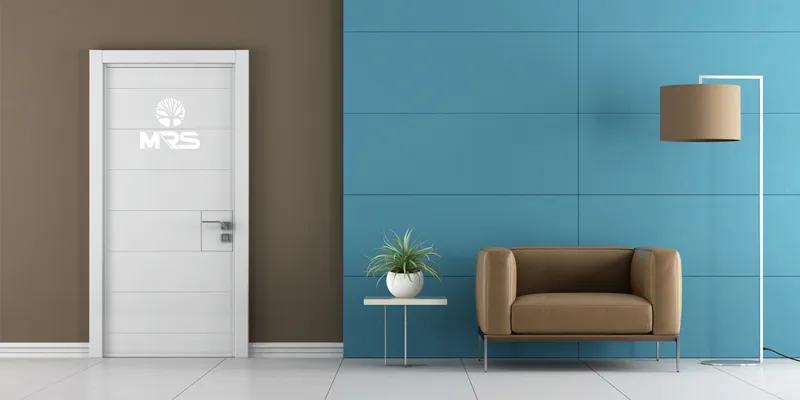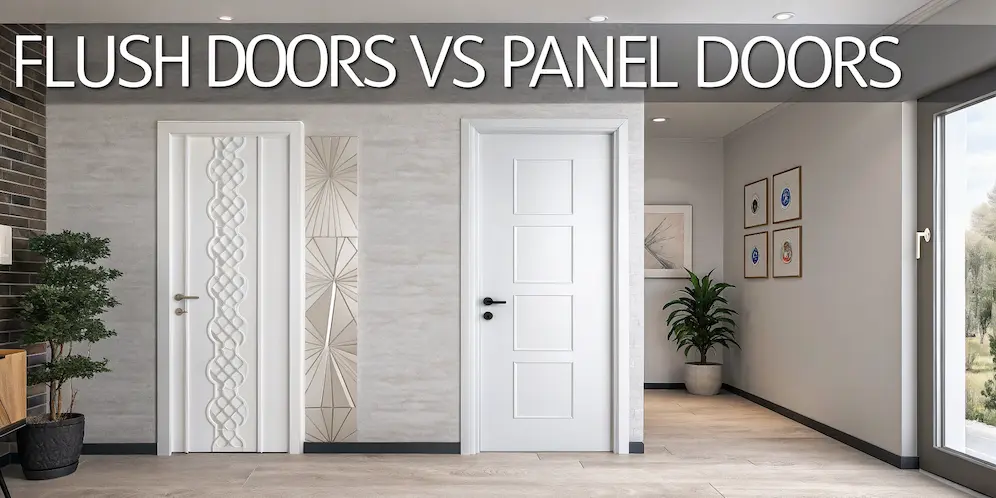When choosing the right door for your home or office, the debate often narrows down to flush doors vs panel doors. Both types of doors offer distinct advantages, but which one stands out as the superior choice? To answer that, let’s explore the key features, differences, and practical applications of panel doors vs flush doors and . By understanding these factors, you can make an informed decision that best suits your needs.
What Is Flush Door?
A flush door is known for its sleek, minimalistic design. It has a flat, even surface without any raised or recessed panels, giving it a modern and clean look. Flush doors are typically made of a solid core material, such as plywood or MDF, sandwiched between thin sheets of veneer or laminate. This structure makes flush panel doors lightweight, sturdy, and highly durable.
Flush doors are often used in contemporary interiors due to their simplicity and versatility. Their design allows them to blend seamlessly with any decor, making them ideal for both residential and commercial spaces.
What Is Panel Door?
Panel doors, on the other hand, have a more traditional appearance. They are made by joining several panels of wood, which can be raised or recessed, creating a decorative design. Panel doors come in various styles, from classic to modern, and are often used in homes where aesthetic detail and elegance are important.
These doors are constructed from solid wood or engineered wood, offering a robust and heavy-duty option. Panel doors are available in different designs, including four-panel, six-panel, or eight-panel configurations, giving homeowners plenty of design flexibility.

Difference Between Flush Door And Panel Door
While both flush doors and panel doors serve the same basic purpose, their design, construction, and functionality differ significantly.
- Design: The most obvious difference between flush doors and panel doors is their appearance. Flush doors have a smooth, flat surface, while panel doors feature intricate designs with raised or recessed panels.
- Construction: Flush panel doors are generally hollow or solid-core with a laminate or veneer finish. Panel doors, however, are made from solid wood or engineered wood with individual panels, making them heavier and more detailed.
- Cost: Flush doors tend to be more affordable due to their simpler construction, while panel doors are typically more expensive, especially if they’re made from solid wood.
- Durability: Flush doors are highly durable and resistant to warping or cracking, thanks to their solid-core or hollow-core structure. Panel doors, while robust, can be prone to issues like shrinking or warping over time, particularly if they are made from solid wood.
- Maintenance: In terms of maintenance, flush doors are easy to clean and require minimal upkeep due to their smooth surface. Panel doors may require more maintenance, as dirt and dust can accumulate in the grooves and panels.
- Aesthetic Appeal: Panel doors are often chosen for their aesthetic appeal, especially in traditional homes, where intricate detailing is desired. Flush doors, on the other hand, offer a modern, minimalistic aesthetic, making them perfect for contemporary spaces.
Pros And Cons Of Flush Doors vs Panel Doors
To further understand the flush door and panel door difference, let’s look at the pros and cons of each type.
Pros Of Flush Doors
- Cost-Effective: Flush doors are more affordable compared to panel doors.
- Minimalist Design: Their clean, modern look makes them a great fit for contemporary homes.
- Easy Maintenance: With a flat surface, they are easy to clean and maintain.
- Soundproofing: Solid flush doors offer excellent insulation and noise reduction.
Cons Of Flush Doors
- Less Decorative: Flush doors may lack the visual appeal some homeowners seek.
- Durability: They may not be as durable as panel doors, especially in high-traffic areas.
Pros Of Panel Doors
- Aesthetic Appeal: The detailed design of panel doors adds character and elegance to any space.
- Sturdy Construction: Panel doors made of solid wood are highly durable.
- Variety of Designs: Panel doors come in various styles, allowing customization to suit different home décors.
Cons Of Panel Doors
- Costly: The intricate design and solid materials make them more expensive.
- Maintenance: They may require more upkeep to maintain their beauty over time.
Why Choose Flush Doors Over Panel Doors?
When deciding between flush doors vs panel doors, there are several reasons why flush doors may be the superior choice, particularly for modern homeowners or businesses.
- Affordability: Flush doors are more cost-effective compared to panel doors, making them an excellent option for those on a budget. Despite their lower price point, they still offer durability and style.
- Ease of Maintenance: If you’re looking for a door that requires minimal maintenance, a flush door is the way to go. Its smooth surface is easy to wipe down, and there are no grooves or panels where dust can settle.
- Durability: Thanks to their solid-core construction, flush doors are less likely to warp or crack over time. This makes them ideal for areas with fluctuating temperatures or high humidity.
- Versatile Design: While panel doors offer more decorative elements, flush doors are versatile enough to fit into any design scheme. Whether you’re looking for a door for your office, bedroom, or bathroom, a flush panel door can provide a seamless and cohesive look.
Best Applications For Flush And Panel Doors
Flush doors are ideal for:
- Modern and contemporary interiors
- Commercial spaces such as offices and retail stores
- Areas requiring easy maintenance, such as bathrooms and kitchens
Panel doors are best suited for:
- Traditional homes with decorative interiors
- Main entry doors where a solid and decorative design is desired
- Living rooms and formal areas where elegance is a priority
Conclusion
In the battle of flush doors vs panel doors, the right choice depends on your specific needs, budget, and design preferences. For those who prioritize modern design, ease of maintenance, and affordability, flush doors are the clear winner. They offer a sleek, minimalist aesthetic and are more durable and cost-effective than panel doors.
However, if you’re looking to add a touch of elegance and tradition to your space, panel doors may be the better choice. Their intricate designs and sturdy construction make them ideal for homes with a more classic style.Ultimately, both flush panel doors and panel doors have their strengths. The superior choice comes down to your personal preferences and the specific requirements of your project.
What Is The Difference Between Flush Doors And Panel Doors?
The main difference between flush doors and panel doors is in their design and construction. Flush doors have a flat, smooth surface, while panel doors feature raised or recessed panels for a more decorative look.
Are Flush Doors Cheaper Than Panel Doors?
Yes, flush doors are generally more affordable than panel doors due to their simpler construction and materials.
Can Flush Doors Be Used For Main Entry Doors?
While flush doors are more commonly used for interior spaces, they can also be used for main entry doors, especially in modern homes. However, panel doors are often preferred for entryways due to their solid construction and decorative appeal.
Which Door Is More Durable, Flush Or Panel?
Both doors are durable, but flush doors are more resistant to warping and shrinking due to their solid-core or hollow-core structure. Panel doors can be prone to issues like warping over time, particularly in areas with high humidity.
Are Panel Doors More Difficult To Maintain Than Flush Doors?
Yes, panel doors require more maintenance because dirt can accumulate in the grooves of the panels. In contrast, flush doors have a smooth surface that is easy to clean and maintain.

